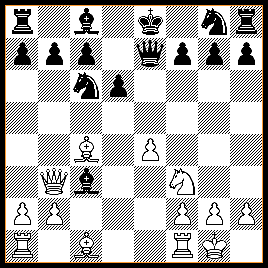Book Reviews by Sam Collins
Game: S. Collins vs L. McShane
 So where better to start than with a tasty morsel from Gambit Publications: Play the Open Games as Black, by John Emms (224 pages, R.R.P. £15.99). So where better to start than with a tasty morsel from Gambit Publications: Play the Open Games as Black, by John Emms (224 pages, R.R.P. £15.99).
John Emms is one of the new breed of English Grandmasters (Joe Gallagher would be another example) who seem to spend most of their time churning out very professional opening manuals. Emms has already dabbled in the French Tarrasch and the Nimzo-Indian, for example (both of which he plays, incidentally), producing efforts, which have generally been well received (though I personally thought his book on the Tarrasch was a bit flat; too little material). Surprise, surprise, he also plays a lot of open games (1...e5 is his main defence to 1 e4, as far as I can see, and he plays 1 e4 as White). Oh yeah, the book...
The first thing I should say about the book is that it does NOT offer a complete repertoire against 1.e4. It deals with everything, which White can play after 1.e4 e5, except the Ruy Lopez. The book is therefore mainly aimed at players who already have a defence against the Lopez, and who want to fill in the gaps if White surprises them earlier on. It is also designed for players who play 1 e4 e5 2 Nf3 Nc6; Petroff, Philidor and (heaven forbid) Latvian players will only find about a third of the book applies to them.
This seems a good idea to me. The 224 page book would either be too long or have to force the price up too high if the author was to recommend something against the Lopez; and probably about half the readers wouldn’t like the proposed line anyway (the defences to the Ruy Lopez are very wide-ranging and cater for numerous styles; no point suggesting the Marshall Gambit to a quiet positional player, for example). So Emms narrows his subject matter, thus enabling him to treat it more effectively. Emms recently wrote a book on the Ruy Lopez from White’s point of view, so it wouldn’t have been too difficult for him to research a Black defence; I honestly think that the decision to exclude the Ruy Lopez from this book was a well-considered one.
Emms bases his proposed repertoire on well-established main lines: 2...Nf6 against the Vienna, 2...exf4 against the King’s Gambit (followed, after 3 Nf3, by 3...g5 or 3...h6), 4...Nf6 against the Scotch, and the Two Knight’s Defence against the Italian Game. So the reader is certainly treading on rather solid ground when he plays these variations.
The structure of the book is quite simple; a brief introduction to the line being discussed, sometimes with an illustrative game or a recurring idea Emss sees fit to point out. He then has ‘A Quick Summary of the Recommended Lines’, where he gives his opinion on the proposed variations; which he prefers, which are popular, which deserve more attention. This section is really excellent to help guide the reader through the material which follows, and is something I think no opening book should be without.
Having breezed through the easy stuff, we come to the Theory section. This is arranged in the traditional ‘variations’ format rather than in complete games. While I know that many people like the complete games approach, in this case I think that Emms is right in rejecting it; having three or four games to deal with the variation 1 e4 e5 2 d4 exd4 3 Qxd4 (and you would certainly need three or four in view of the great choice at White’s disposal at virtually every move) is simply crazy when Emms can deal with it in great detail in only two pages.
The theoretical sections are, in general, quite easy to work through, without sacrificing thoroughness. Emms is careful to keep offering verbal assessment while giving us the moves and analysis relevant to a particular variation. It is clear that he has carefully analysed anything proposed in the book, and not contented himself (as, unfortunately, too many opening authors do) with merely giving re-hashed analysis from other sources, or refusing to deal with a move just because it hasn’t been seen in practical play yet.
For instance, after 1 e4 e5 2 Nf3 Nc6 3 d4 exd4 4 c3 dxc3 5 Nxc3 Bb4 6 Bc4 d6 7 Qb3 Qe7 8 0-0 Bxc3 (D)

Emms wrote: I can’t find a single example of 9 Qxc3 here, even though it may well be White’s best move! The point is that after 9...Nf6 10 Re1 White prepares to blast open the position with e5, an action that will benefit his bishop pair:
a) Attempts by Black to keep the position semi-closed are not all that convincing. For example, after 10...Ne5 White has the awkward 11 Bb5+!, which is not easy to meet. I can’t say that Black is comfortable with 11...Bd7 12 Bxd7+ Kxd7 13 Nd4, 11...c6 12 Nxe5 cxb5 (12...dxe5? 13 Bxc6+!) 13 Nc6! Qc7 14 Nd4 or 11...Kf8 12 Nd4.
b) So it seems Black should simply play 10...0-0, allowing 11 e5 Nxe5 12 Nxe5 dxe5 13 Rxe5. White obviously has some play for the pawn after 13...Qd6 14 Bf4, while 13...Be6!? 14 Bxe6 fxe6 14 Qb3 c6 16 Qxe6+ Qxe6 17 Rxe6 Kf7 bails out into a level endgame. If no improvements can be found for Black here, then he should consider capturing on c3 earlier, forcing White to recapture with the pawn.
(By the way, Emms had previously shown where to interpose ...Bxc3, and gave some examples showing why can’t play it at other points)
This is one of the more impressive examples, but it is merely an illustration of the care with which Emms treats his material.
He draws on a broad range of games, ranging from the 1800’s to 1999, and he also uses many correspondence games. He frequently offers a choice of lines for Black, so I think that the chances of the reader finding himself without a playable recommendation against a particular variation are very slim indeed, although of course master strength players will want to keep abreast of whatever games came out since the publication of the book, particularly in critical lines like the 4.Ng5 Two Knight’s Defence.
The time has come for me to give my opinion on the book. I think that Emms has done a fine job with this work. His coaching experience comes across well as he clearly explains his recommended variations, and he keeps the reader’s attention by offering constant assessment within the framework of a very attractively laid out book, with many diagrams and virtually no white spaces. There is a definite feeling of achievement experienced by the reader when he finishes a section, knowing that he is almost certainly as well prepared as his next opponent and, as I mentioned before, it is quite easy going material compared to the bulkier theoretical works which we all use to prop up the coffee table. I particularly find Emms effortless knowledge of move-order very helpful; since he plays many of the lines concerned, he knows which moves reduce the opponent’s options, which lines transpose, where the reader needs to know other lines to combat alternative move-orders by White, etc.
But the thing I like the most about this book is the effort put in by Emms. The number of points where he offers original analysis, or where he disagrees with previously accepted analyses, convince me that he put a lot of thought into this work.
Are there points where the book could be improved? Well, I think that international players would prefer more space allocated to things like the Scotch and the Two Knight’s Defence at the expense of some of the really irregular stuff, which they can happily deal with over the board. But this could not be avoided when the possible readership is as broad as it is in this case (in my opinion, 1500 players up to grandmasters will gain a lot from this book). I think that anyone who plays against the Ruy Lopez should get this book. Any Petroff or Philidor players might consider buying the book to deal with stuff like the King’s Gambit, and to facilitate expanding their repertoire to include systems with 1.e4 e5 2.Nf3 Nc6. International players may want to supplement this book with more recent games, but they will still find it very useful, I think. All in all, another excellent book from Gambit Publications, and a fine effort from a fine author.
My evaluation: * * * * *
Other reviews by Sam Collins
Review 1: Play the Open Games as Black, by John Emms
Review 2: The Human Comedy of Chess: A Grandmaster’s Chronicles by GM Hans Ree & Storming the Barricades by GM Larry Christiansen
Review 3: Open Ruy Lopez by Glenn Flear
Review 4: Main Line Caro-Kann by Neil McDonald
Review 5: Offbeat Spanish by Glenn Flear
Review 6: Excelling at Chess by Jacob Aagard
Review 7: Can You Be a Positional Chess Genius? by Angus Dunnington
Review 8: The Grunfeld Defence by Nigel Davies
Review 9: The Best of Chess Cafe
Review 10: How To Build Your Chess Opening Repertoire by Steve Giddins
|


